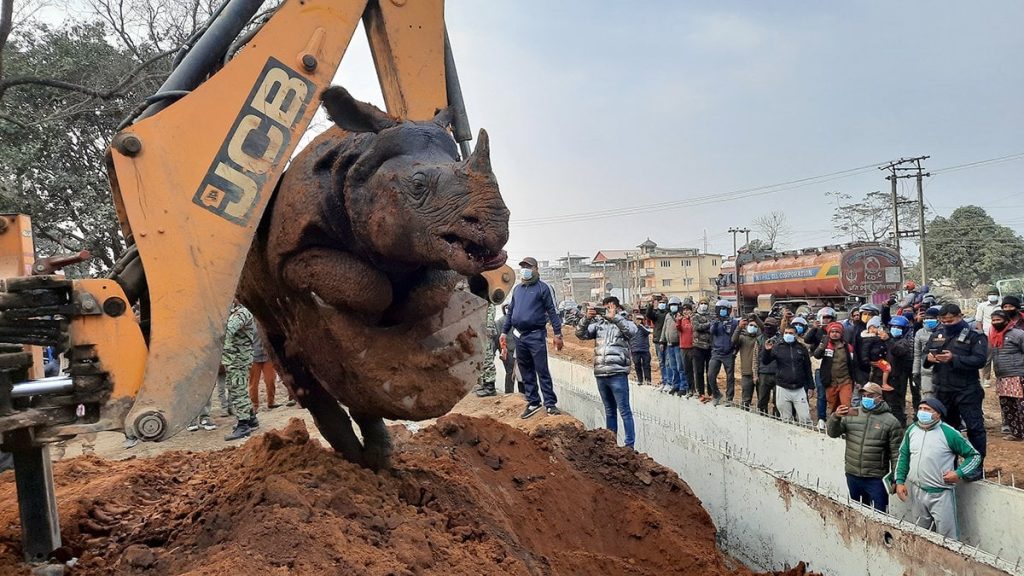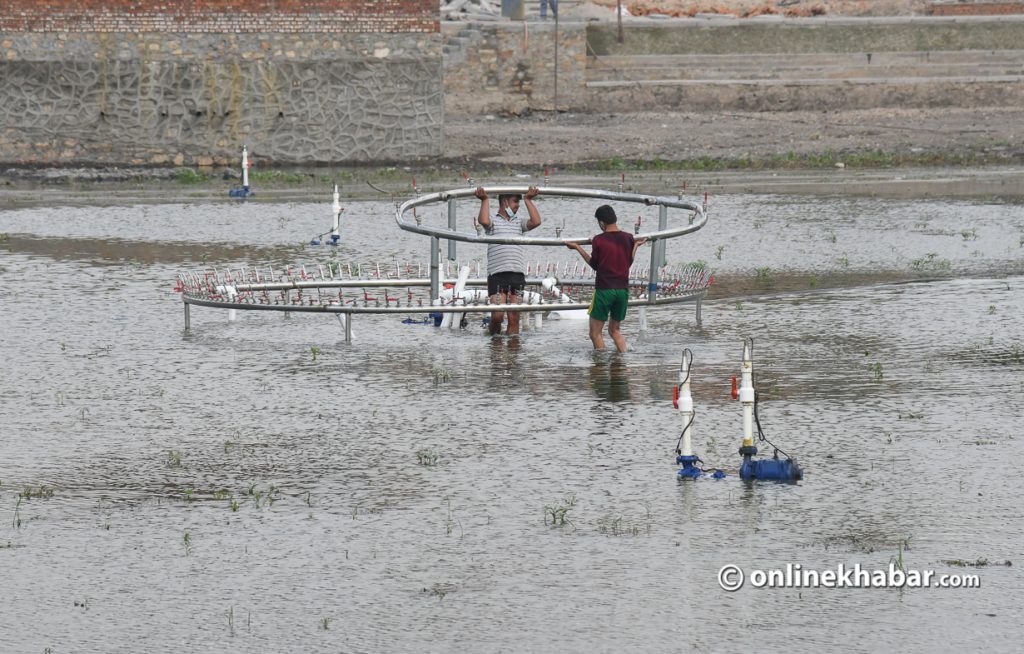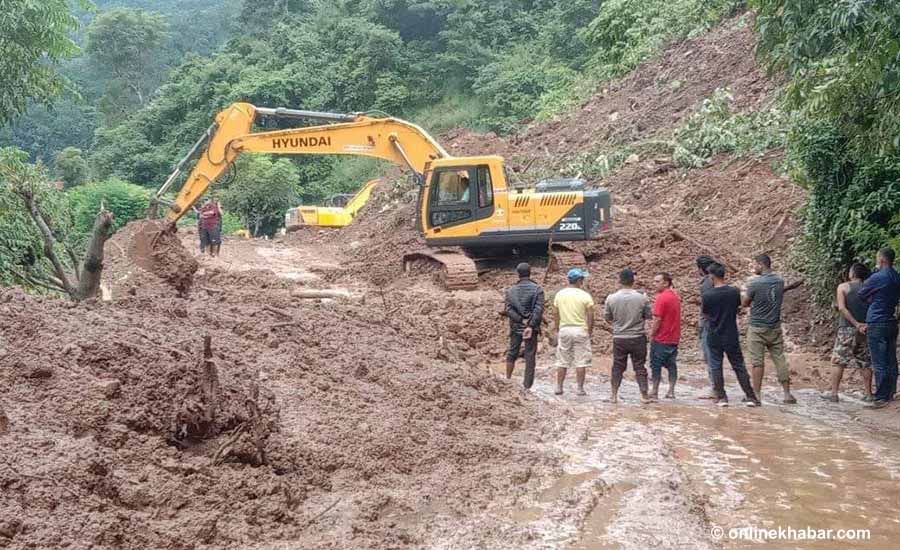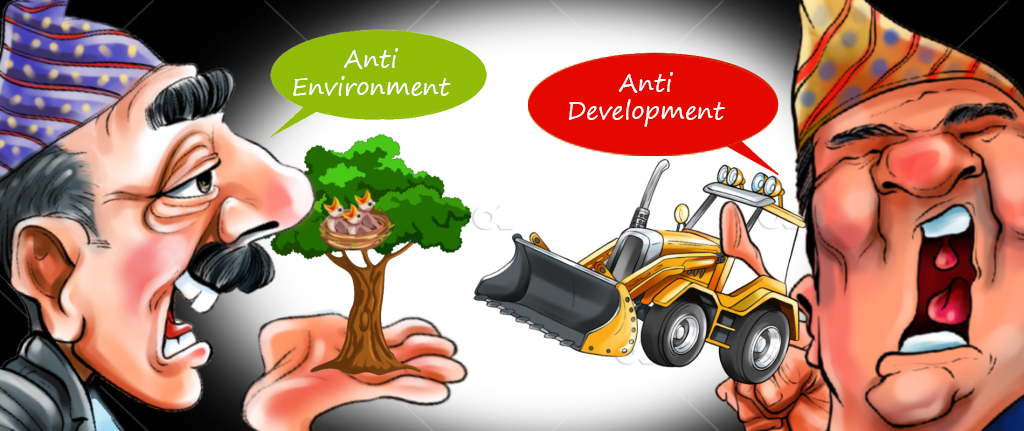On February 8, 2022, a Malabar silk-cotton tree (commonly known as simal in Nepal) that was along the Prithvi Highway was cut down. On the tree was a nest of a griffon vulture, an endangered species. Pokhara Bird Society on January 4 had asked the Department of Roads to not cut down the tree as the griffon vulture had laid an egg there. No one listened to the organisation and the tree was brought down angering conservationists.
The reason for them getting angry was valid too. Out of the nine types of vultures found in the country, the griffon vulture is the most endangered. Expert says that they had found four places in the country where the griffon vulture had laid eggs. Government bodies and bird conservationists are still at odds over this.
The incident took place during a time when wildlife activists were criticising the death of a rhino that fell inside a ditch in Chitwan on January 23.
Over the past decade, Nepal has been trying to find the right environment-development balance, but due to haphazard planning of development projects, Nepal has not been able to find it. While conservation experts claim the country is trying to destroy nature, the other side has been calling these people anti-development. Due to not being able to find the right balance, a lot of development projects in the country are in limbo.
Crucial conflicts

In some way, environmental activists are right. The rhino died in Chitwan due to the carelessness of the contractors and project managers. The committee formed to investigate the case in its report also blamed the District Forest Office and Chitwan National Park. In the report, the committee mentioned how the road was being built in an unsafe manner given how close it was to the national park.
This goes to show how many development projects in the country are carried out without due research on what damage it could do to the wildlife and the environment. And, that is what frustrates wildlife activists who say these incidents would not be a problem if the people responsible for the construction of these projects were sensitive and careful about this issue.
Recently, the Gaurishankar Conservation Area Project (GCAP) and different hydropower development projects to be constructed in the area are at odds. The GCAP has been asking these projects not to start construction until they got its permission. It has also asked them for an environmental impact assessment (EIA).
But, the hydro projects have been stating all their initial work on the project has stopped because of the EIA. Bimal Gurung, the deputy manager of the Upper Tamakoshi Hydropower Project, says it was impractical to ask for an EIA during the initial stage of the project.
Bigu rural municipality has also been speaking against the GCAP alleging it of halting the progress of different projects that will fall in its rural municipality.
Yudhisthira Khadka, the chair of the rural municipality, says that it was unconstitutional on the GCAP’s part to halt the construction of these projects due to the EIA.
“If we only think about the environment, we will never develop,” says Khadka.
Another example is the exploitation of the Kamala river. Dhanusha police on February 14 took control of seven tippers and one excavator. After that, police found out that these tippers were deployed by the China Railway Engineering Group that was given the job of expanding the Kamala-Kanchanpur section of the East-West Highway.
Police say that the Chinese company does not have permission to extract anything from the river. But, the company argues that as it was building a road section along the river, it should be allowed to do so. Even the Department of Roads is siding with the Chinese team as it wants these roads completed as soon as possible.

The issue of environmental balance in development projects has also engulfed the Kathmandu valley. Despite the protest, the Kathmandu metropolitan city is preparing to inaugurate the renovated Kamalpokhari. Activists had criticised the way the KMC was killing the ecosystem of the pond by using concrete. Despite that, the project went ahead.
The KMC says it had consulted experts and heritage campaigners, but these people say that the plan to use concrete on the pond was made at the start and the KMC did not want to go off track and build the pond it wanted to after noise settled. As plans to build a fibre lotus in the middle of the pond is going ahead, water experts say the pond could no longer be called a wetland.
Another project that has been in limbo due to the conservation vs development debate is the Kathmandu-Terai Fast Track. Nepal Army, which is carrying out the project has asked the government to allow it to work in sections where the EIA is yet to be done.
Project head Bikash Pokharel says that the army has seen that it needs to acquire land in areas where the EIA has not been done and is asking the government to act fast if it wants to complete the project on time. He says the project cannot move forwards because the army cannot cut trees in areas where the EIA has not been done without the government’s permission.
But, the Ministry of Forest and Environment is yet to agree with the army as it understands doing the EIA after work is done in the area is wrong. But, the army has been putting pressure on the government to move things swiftly.
Environment v development

Not finding the right balance between conservation and development has led to multiple problems resulting in small to major development projects being incomplete.
Government officials themselves are at odds. A verbal argument took place at the Delegated Legislation and Government Assurance Committee of the National Assembly in early January. In the committee, then defence secretary Baburam Adhikari had shown his displeasure on how the Ministry of Forest and Environment had taken over nine months to give them permission to cut down trees. Supporting Adhikari, a joint-secretary at the Ministry of Physical Infrastructure told the committee that the forest ministry had taken a decade to give his ministry permission to cut down trees even though the ministry and government had a theoretical agreement.
In reply, the Department of Forests and Soil Conservation’s director-general Man Bahadur Khadka told them that being a national pride project would not exempt development projects from following rules and regulations. He even accused some leaders and ministers of giving permission without consulting them.
“We can’t allow anyone to cut more trees than what was agreed upon,” Khadka said during the meeting.
Experts say that for development projects, there needs to be some destruction of nature. But, despite that, they say concerned bodies should focus on doing minimal destruction. They say that with policy mostly favouring destruction, conservation has taken a back seat. The tussle between different government bodies has not also helped, say experts.
Environmentalist Bhushan Tuladhar says Nepal has a problem because it sees development only through the construction of roads and different development projects. Limiting the idea to this and forgetting social development is a major reason why development projects have not picked up in the country, he says.
“Prosperity doesn’t always mean money. We needed to understand that. We need to try and leave behind resources to the coming generation too so when working on megaprojects, we need to think about the future,” says Tuladhar, adding it was time Nepal started to take environment and development hand in hand.
Infrastructure expert Surya Raj Acharya says Nepal should start assessing the pros and cons of these development projects rather than just objecting to them.
“I think being against something is becoming trendy. We need to think and do our due research before taking a stance,” he says.
Environment assessment mere formality
Nepal has rules regarding balancing development and demolishment. But over the years, these rules have become a mere formality.
According to the Environment Protection Act, all major development projects need to do their environmental impact assessment (EIA) and smaller ones need to do their initial environment examination (IEE). These reports should mention the impact of the project on the surrounding environment and what could be done to minimise it.
But, Acharya says these reports are just a formality, and hence development projects have caused major damages to the surrounding. Landslides and flash floods in various areas are a result of this.
Due to a poorly prepared report, over 1,000 extra trees were cut during the Narayanghat-Muglin road expansion. A similar case is repeating in the fast track as the army says it needs to cut down more trees.
Wrath of nature

Even though suggestions are included in the reports, development projects do not go by them and do things they want to do. Most EIA reports say that all hydropower plants should release 10 per cent water during the winter seasons. But, not everyone follows this. A lot of these projects ask someone they know to prepare the EIA where they only add things the project is willing to do.
Tuladhar says the problem lies in not paying attention to the mistakes. He says if development projects cut down 1,000 trees, they shall plant 1,000 trees. But, in Nepal, they hardly do this. Even though some do an afforestation campaign, they hardly take care of these plants.
“We cut down 1,200 trees during the ring road expansion, but did we plant trees to replace them?,” says Tuladhar.
Development projects, to save face, have been stating they have not been able to plant trees because they cannot find land. They also say when they go to the Forest Ministry, it doesn’t take their concern seriously.
A former member of the National Planning Commission, Krishna Prasad Oli, says that he is concerned with the “dozer development” that has taken place in the hills of Nepal. These roads have been paved without environmental assessment resulting in landslides in the area.
“Yes, people benefit from the roads. But, we needed to look at the ripple effect and how it is wasting taxpayers’ money,” says Oli.
Experts say development projects can only get better if Nepal starts implementing things written in the EIA. Tuladhar says it was time Nepal studied what other countries do and follow it.
“We can learn good habits from these countries and work towards protecting the environment,” he says.
Tuladhar says that Nepal’s hills and mountains are fragile because they are the youngest in the world. He says people need to understand this before planning development projects in these regions because they will have a ripple effect in the long run.

























